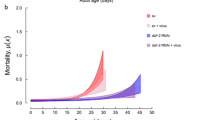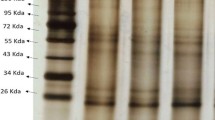Abstract
Encapsulation is an effective cellular immunity feature in insects, but the mechanism by which hemocytes recognize and encapsulate invading nematodes remains unclear. In addition, insect susceptibility to nematodes differs, indicating differences in immunity. We compared cellular encapsulation with non-parasitic and parasitic nematodes in two lepidopteran insects in vivo and ex vivo. The percentage of the free-living nematode Caenorhabditis elegans (Maupas) (Rhabditida: Rhabditidae) encapsulated following injection into Galleria mellonella Linnaeus (Lepidoptera: Pyralidae) larvae in vivo was low, whereas most larvae were encapsulated in Mythimna separata walker (Lepidoptera: Noctuidae). Similarly, the entomopathogenic nematode Steinernema carpocapsae (Rhabditida: Steinernematidae) was rarely encapsulated in G. mellonella, but > 50% were encapsulated in M. separata. Adhesion of G. mellonella hemocytes on the surface of live C. elegans was infrequently observed ex vivo, whereas dead nematodes were partially covered with hemocytes. A significantly higher percentage of live nematodes was covered with hemocytes in M. separata in the presence and absence of insect plasma compared with G. mellonella. These results indicate that there is a difference in immunity against nematodes between the two insects and that the difference largely depends on the capabilities of the hemocytes.




Similar content being viewed by others
References
Alvandi J, Karimi J, Dunphy GB (2014) Cellular reactions of the white grub larvae, Polyphylla adspersa, against entomopathogenic nematodes. Nematology 16:1–12
Balasubramanian N, Hao YJ, Toubarro D, Nascimento G, Simões N (2009) Purification, biochemical and molecular analysis of a chymotrypsin protease with prophenoloxidase suppression activity from the entomopathogenic nematode Steinernema carpocapsae. Int J Parasitol 39:975–984
Balasubramanian N, Toubarro D, Simões N (2010) Biochemical study and in vitro insect immune suppression by a trypsin-like secreted protease from the nematode Steinernema carpocapsae. Parasite Immunol 32:165–175
Bass DA, Szejda P (1979) Eosinophils versus neutrophils in host defense. Killing of newborn larvae of Trichinella spiralis by human granulocytes in vitro. J Clin Invest 64:1415–1422
Blandin S, Levashina EA (2004) Thioester-containing proteins and insect immunity. Mol Immunol 40:903–908
Cerenius L, Soderhall K (2004) The prophenoloxidase-activating system in invertebrates. Immunol Rev 198:116–126
Chen CC, Laurence BR (1985) The encapsulation of the sheaths of microfilariae of Brugia pahangi in the haemocoel of mosquitoes. J Parasitol 71:834–836
Christensen BM, Forton KF (1986) Hemocyte-mediated melanization of microfilariae in Aedes aegypti. J Parasitol 72:220–225
Dunphy GB, Webster JM (1987) Partially characterized components of the epicuticle of dauer juvenile Steinernema feltiae and their influence on hemocyte activity in Galleria mellonella. J Parasitol 73:584–588
El-Sadr WM, Aikawa M, Greene BM (1983) In vitro immune mechanisms associated with clearance of microfilariae of Dirofilaria immitis. J Immunol 130:428–434
Fuchi M, Ono M, Kondo E, Yoshiga T (2016) Axenic liquid static culture of entomopathogenic nematode Steinernema carpocapsae supplemented with nematode-infected insect cadaver. Nematol Res 46:25–29
Gillespie JP, Kanost MR, Trenczek T (1997) Biological mediators of insect immunity. Annu Rev Entomol 42:611–643
Han LB, Huang LQ, Wang CZ (2013) Host preference and suitability in the endoparasitoid Campoletis chlorideae is associated with its ability to suppress host immune responses. Ecol Entomol 38:173–182
Imler JL, Bulet P (2005) Antimicrobial peptides in Drosophila: structures, activities and gene regulation. Chem Immunol Allergy 86:1–21
Irving P, Ubeda JM, Doucet D, Troxler L, Lagueux M, Zachary D, Hoffmann JA, Hetru C, Meister M (2005) New insights into Drosophila larval haemocyte functions through genome-wide analysis. Cell Microbiol 7:335–350
Kacsoh BZ, Schlenke TA (2012) High hemocyte load is associated with increased resistance against parasitoids in Drosophila suzukii, a relative of D. melanogaster. PLoS ONE 7:e34721
Labrosse C, Eslin P, Doury G, Drezen JM, Poirié M (2005) Haemocyte changes in D. Melanogaster in response to long gland components of the parasitoid wasp Leptopilina boulardi: a Rho-GAP protein as an important factor. J Insect Physiol 51:161–170
Lackie AM (1988) Haemocyte behavior. Adv Insect Physiol 21:85–178
Lavine MD, Strand MR (2002) Insect haemocyte and their role in immunity. Insect Biochem Mol Biol 32:295–309
Lemaitre B, Hoffmann J (2007) The host defense of Drosophila melanogaster. Annu Rev Immunol 25:697–743
Li XY, Cowles RS, Cowles EA, Gaugler R, Cox-Foster DL (2007) Relationship between the successful infection by entomopathogenic nematodes and the host immune response. Int J Parasitol 37:365–374
Li X, Cowles EA, Cowles RS, Gauglerd R, Cox-Foster DL (2009) Characterization of immunosuppressive surface coat proteins from Steinernema glaseri that selectively kill blood cells in susceptible hosts. Mol Biochem Parasitol 165:162–169
Mastore M, Brivio MF (2008) Cuticular surface lipids are responsible for disguise properties of an entomoparasite against host cellular responses. Dev Comp Immunol 32:1050–1062
Muta T, Iwanaga S (1996) The role of hemolymph coagulation in innate immunity. Curr Opin Immunol 8:41–47
Ono M, Yoshiga T (2018) Cellular immunity in the insect Galleria mellonella against insect non-parasitic nematodes. Parasitology 146:708–715
Ono M, Arimatsu C, Yoshiga T (2020) Ex vivo observation of insect hemocyte behavior against beads and nematodes in the presence of insect plasma. Appl Entomol Zool 55:65–70
Pech LL, Strand MR (1996) Granular cells are required for encapsulation of foreign targets by insect haemocytes. J Cell Sci 109:2053–2060
Phillips DR, Clark KD (2017) Bombyx mori and Aedes aegypti form multi-functional immune complexes that integrate pattern recognition, melanization, coagulants, and hemocyte recruitment. PLoS ONE 12:e0171447
Ratcliffe NA (1993) Cellular defense responses of insects: unresolved problems. In: Beckage NE, Thompson SN, Federici BA (eds) Parasites, parasites and pathogens of insects, vol I. Academic Press, San Diego, pp 267–304
Sanda NB, Muhammad A, Ali H, Hou Y (2018) Entomopathogenic nematode Steinernema carpocapsae surpasses the cellular immune responses of the hispid beetle, Octodonta nipae (Coleoptera: Chrysomelidae). Microb Pathog 124:337–345
Sato S, Akai H, Sawada H (1976) An ultrastructrural study of capsule formation by Bombyx hemocytes. Ann Zool Japan 49:177–188
Schmidt O, Schreiber A (2006) Integration of cell adhesion reactions—a balance of forces? J Theor Biol 238:608–615
Schmit AR, Ratcliffe NA (1977) The encapsulation of foreign tissue implants in Galleria mellonella larvae. J Insect Physiol 23:175–184
Shi XZ, Kang CJ, Wang SJ, Zhong X, Beerntsen BT, Yu XQ (2014) Functions of Armigeres subalbatus C-type lectins in innate immunity. Insect Biochem Mol Biol 52:102–114
Stiernagle T (1999) Maintenance of C. elegans. In: Hope I (ed) C. elegans: a practical approach. Oxford University Press, Oxford, pp 51–67
Strand MR (2008) The insect cellular immune response. Insect Sci 15:1–14
Strand MR, Noda T (1991) Alterations in the haemocytes of Pseudoplusia includens after parasitism by Microplitis demoliror. J Insect Physiol 37:839–850
Strand MR, Pech LL (1995) Immunological basis for compatibility in parasitoid–host relationships. Annu Rev Entomol 40:31–56
Strand MR, Clark KC, Gardiner EM (1999) Plasmatocyte spreading peptide does not induce Microplitis demolitor polydnavirus-infected plasmatocytes to spread on foreign surfaces. Arch Insect Biochem Physiol 40:41–52
Sudhaus W (2008) Evolution of insect parasitism in rhabditid and diplogastrid nematodes. In: Makarov SE, Dimitrijevic RN (eds) Advances in arachnology and developmental biology. Institute of Zoology, Belgrade, pp 143–161
Theopold U, Schmidt O, Söderhäll K, Dushay MS (2004) Coagulation in arthropods: defence, wound closure and healing. Trends Immunol 25:289–294
Toubarro D, Avila MM, Montiel R, Simoes N (2013) A pathogenic nematode targets recognition proteins to avoid insect defenses. PLoS ONE 8:e75691
Tsuzuki S, Matsumoto H, Furihata S, Ryuda M, Tanaka H, Sung EJ, Bird GS, Zhou Y, Shears SB, Hayakawa Y (2014) Switching between humoral and cellular immune responses in Drosophila is guided by the cytokine GBP. Nat Commun 5:4628
Wang X, Fuchs JF, Infanger LC, Rocheleau TA, Hillyer JF, Chen CC, Christensen BM (2005) Mosquito innate immunity: involvement of beta 1,3-glucan recognition protein in melanotic encapsulation immune responses in Armigeres subalbatus. Mol Biochem Parasitol 139:65–73
Wang P, Zhuo XR, Tang L, Liu XS, Wang YF, Wang GX, Yu XQ, Wang JL (2017) C-type lectin interacting with β-integrin enhances hemocytic encapsulation in the cotton bollworm, Helicoverpa armigera. Insect Biochem Mol Biol 86:29–40
Wiesner A (1991) Induction of immunity by latex beads and by hemolymph transfer in Galleria mellonella. Dev Comp Immunol 15:241–250
Wiesner A (1992) Characteristics of inert beads provoking humoral immune responses in Galleria mellonella larvae. J Insect Physiol 38:533–541
Yokoo S, Tojo S, Ishibashi N (1992) Suppression of the prophenoloxidase cascade in the larval haemolymph of the turnip moth, Agrotis segetum by an entomopathogenic nematode, Steinernema carpocapsae and its symbiotic bacterium. J Insect Physiol 38:915–924
Yu XQ, Kanost MR (2004) Immulectin-2, a pattern recognition receptor that stimulates hemocyte encapsulation and melanization in the tobacco hornworm, Manduca sexta. Dev Comp Immunol 28:891–900
Funding
This study was funded by Challenging Exploratory Reserch (Grant No. 23658051) and Scientific Research (Grant No. 18K05676).
Author information
Authors and Affiliations
Corresponding author
Additional information
Publisher's Note
Springer Nature remains neutral with regard to jurisdictional claims in published maps and institutional affiliations.
Electronic supplementary material
Below is the link to the electronic supplementary material.
13355_2020_687_MOESM1_ESM.pdf
Supplement 1. Modified Baermann method. A) Components for separation of nematodes. Lid of a 50 ml conical tube whose top was removed. A 50 ml conical tube that was cut at the center and the bottom part was removed. Two square-shaped pieces of Kimwipes (about 6 × 6 cm). B) Assembly: The Kimwipes pieces were placed at the top end of the 50 ml conical tube and fixed at the top with the lid of the conical tube. C) The assembled equipment was placed in a 100 ml beaker with 20 ml water. To sterilize the system, the equipment (C) was placed in a 50 ml glass beaker, and the beaker was wrapped with aluminum foil and autoclaved (120 °C, 1.2 atm, for 20 min) (PDF 2080 kb)
Rights and permissions
About this article
Cite this article
Ono, M., Arimatsu, C., Kakinoki, A. et al. Comparison of cellular encapsulation with nematodes in two lepidopteran insects. Appl Entomol Zool 55, 337–344 (2020). https://doi.org/10.1007/s13355-020-00687-6
Received:
Accepted:
Published:
Issue Date:
DOI: https://doi.org/10.1007/s13355-020-00687-6




